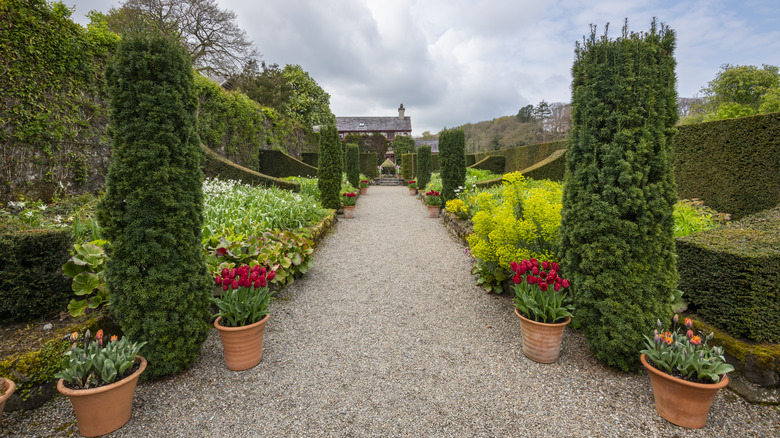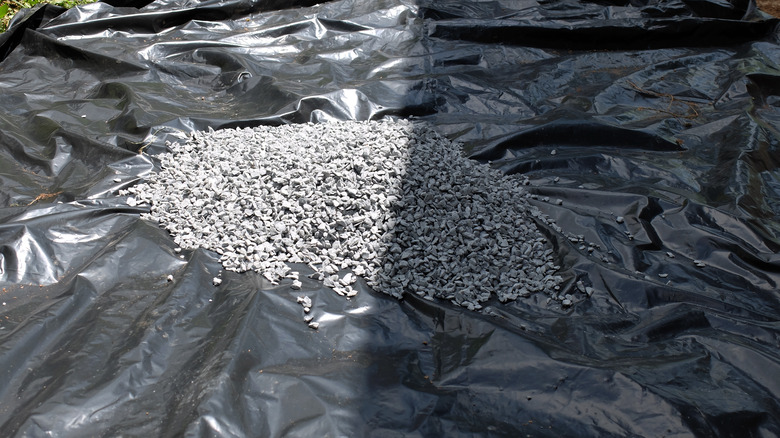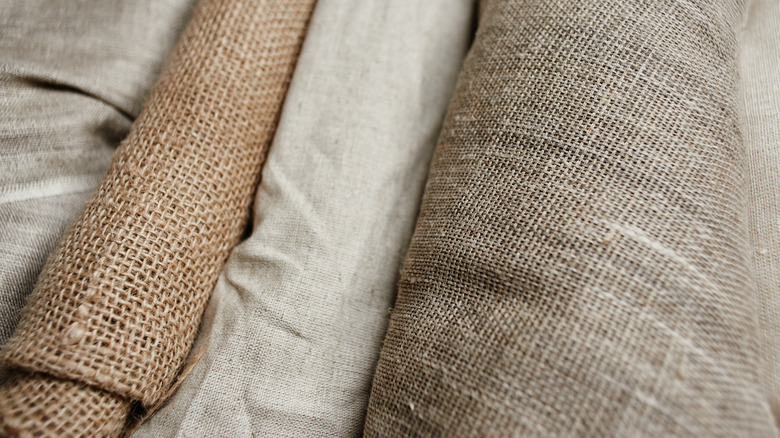Alternatives To Using Landscape Fabric Under Gravel To Prevent Weeds
We may receive a commission on purchases made from links.
The best way to remove weeds from your gravel driveway, path, or garden bed is to prevent them, and landscaping fabric is the go-to option for making this happen. Although landscaping fabric has tons of benefits, like keeping gravel from sinking, its detractors claim that it's not eco-friendly, it's pricey, and it makes weeding harder. Alternatives worth exploring include plastic sheetings, burlap fabric, paper products (like cardboard and newspaper), and gravel grid systems with geotextile membranes. Perhaps surprising to some, foregoing a barrier altogether is another popular option.
Which material you choose to use depends on how long you want your gravel garden feature to last before having to re-do it. Organisms in the soil find organic materials like burlap, cardboard or newspaper pretty tasty; they'll munch on them, breaking them down over time. Eventually, weeds will make their way through as the material disintegrates and the barrier weakens. While the added organic matter is great for your soil health, the eventual abundant weed growth isn't so great if you were hoping to create a long-lasting stone pathway, for example, but can work for smaller paths or patios that you may want to reposition or remove someday. Geotextile and plastic sheets, on the other hand, won't break down completely for 50 to 100 years, but they can eventually work their way to the surface as the gravel shifts. They're good for large projects, like driveways, or any features you know you'll want to keep in place for many years. However, as you can probably already tell, it's important to incorporate surface weed control solutions into your maintenance plan no matter what barrier you choose.
Plastic sheeting under gravel stops weeds from springing up
Before landscape fabric hit the market, there was plastic sheeting, and it's still considered a viable option for gravel and stone-covered yards today. It's cheaper than its purpose-made counterpart, making it a great option for those with limited backyard renovation budgets. The cheapest plastic sheets are typically thin blue tarp, like the XTREMECOVERPRO 3.5 millimeter, 8 x 10 foot heavy duty tarp. Thicker sheets can keep weeds at bay longer since they're less likely to tear or develop holes — a common problem with black plastic sheets.
We're not talking trash can liners — think black plastic sheet, HDPE (high-density polyethylene) plastic sheeting, or even tarp. It's an easy swap with landscape fabric since you can apply it in exactly the same way. That is, simply lay it down atop a pre-prepared surface, pin it in place as you go, and pour a layer of gravel over the top until the plastic is completely hidden. Plus, the sheets are large, so just one will often suffice; you don't have to worry about overlapping a bunch of strips or runners to get full weed-suppressing coverage. Plastic sheets and HDPE-made products in particular, are waterproof, UV resistant, and non-biodegradable. However, those features are also where this material's downsides lie. They're non-permeable, meaning water will pool on the surface, turning your gravel pathway into a bog. Tarp isn't great for fostering underground biodiversity, either, since it cuts off oxygen to the soil.
Use a layer of burlap fabric to put the brakes on weeds
Burlap and related fabrics like hemp, jute, or coir are a middle ground between synthetic landscaping fabric and cardboard. The passionate permaculturists among our readership are bound to be fans of this material. Since it's crafted from natural fibers, burlap will eventually break down in the soil, leaving little impact and adding much-needed nutrients. That's why experts recommend using burlap as a mulching material. It's also porous, allowing water to seep through to the ground below and reducing puddles. The fact that burlap and other similar materials decompose is also an Achilles heel. You'll need to replace it more often than you would plastic weed control products. Given all this, burlap wouldn't be a good alternative for heavy-duty landscape fabric when lining an area destined for lots of traffic — like, say, a gravel driveway with lots of heavy cars moving about on it.
You can get burlap sacks at pretty much any hardware store or big box retailer — even Amazon offers solutions like ANPHSIN 4-pack burlap bags. You'll need to overlap the edges, flip them under (not over), and pin them in place to create an effective weed barrier. Alternatively, you can purchase a large roll of burlap, such as the 40-inch wide, 30-foot roll of Burluptuous gardening burlap. If you really don't have the budget for burlap or a similar textile, old wool carpet can be a free or cheap alternative that's still relatively eco-friendly and will keep weeds at bay.
Paper products are surprisingly good weed barriers
Cardboard and newspaper are often used to suppress weeds in garden beds. They're almost always free, after all! Is it really surprising to learn they can be used under gravel, too? Popular Oregon-based gardening YouTuber Axe & Root Homestead swears by using cardboard as a weed barrier, noting in the description of the video that it performs far better than landscaping fabric for blocking weeds. Remove any inorganic materials from the cardboard or newsprint, like Scotch tape, stickers, and staples, and discard anything with shiny or colored ink. Cut cardboard boxes into flat sheets. Lay the sheets out at least two layers thick over the space you want to fill with gravel, making sure they overlap by 6 to 8 inches to eliminate gaps. Gaps are like green lights for weeds. If the sheets are too stiff, wetting them with your garden hose or a watering can will make them more flexible.
You can also use cardboard to smother weeds and plants, then simply leave it in place when you pour the stones. Like burlap fabric, this solution will probably last just a few years at the very most before the cardboard will need replacing. Paper barriers will also last longer in arid climates than damp. Another downside is that paper products are made of cellulose, and it may attract termites. Another option in this same vein is Ram Board floor protection, which is typically used in flooring. It's made of 100% recycled paper, comes in long rolls, and is affordable.
Pair a gravel grid system with geotextile membrane
Gravel grid or gravel mat systems consist of perforated interlocking plastic panels crafted from HDPE, and can be made of 100% recycled materials. This, combined with the fact that they're permeable, means grid systems are an eco-friendly option for heavy-use areas like driveways and carports, despite not being biodegradable. They're easier to walk or roll on than stand-alone gravel, and the frame keeps the gravel in place. The best type of gravel for a landscape pathway created using a grid system is clean gravel with no fines (the dusty, crumbly stuff), which is a more expensive option.
In most cases, gravel grid systems are installed atop a geotextile membrane — a similar looking though wholly different product to landscape fabric. Geotextiles are heftier than their weed mat counterparts and, as such, are used for commercial-grade stabilization and drainage projects. While you wouldn't typically use them in your yard, the material is better than using landscaping fabric where longevity is key. You can use the grids on their own (sans geotextile membrane), but you may get a few more weeds popping through the gravel if you choose that option. Installing these grid systems requires a bit more heavy lifting than other backyard gravel weed barrier options. You'll need to dig down around 4 inches into the ground by hand or with small scale machinery to provide enough space for the geotextile membrane, compacted gravel sub-layer, and the panels of the gravel grid system. Expect to pay anywhere from well under a dollar to over five dollars per square foot for the various kinds of gravel grid systems available in the U.S.
No weed barrier is necessary if you have a quality sub-base and thick gravel
Here's a controversial but undeniably simple trick to kill the weeds growing on your gravel yard: skip the weed barrier altogether. It turns out that most gravel driveways, pathways, and patios don't require an underlay of landscape fabric or any other barrier. The weight and light-blocking density of the stone deters weeds perfectly well on its own — with a few important caveats, of course. Smothering the grass and weeds before putting down your gravel is a non-negotiable step. Use mulch or one of the options listed above: plastic, burlap, or cardboard sheets. You also need to create a quality foundation for your gravel top layer.
Then, dig out and fill the path or patio area and compact just the soil using a tamper. To create an even sturdier, weed-proof sub-layer, add a covering of MOT Type 1, 21A, or another fine aggregate and compact that, too. Keep adding gravel until you near the top of the path's edge. Spray down both dirt and aggregate with water makes it easier to compact. Add edging before filling the area with the final gravel layer. Spread it evenly with a rake. To guarantee a weed-free path and not waste all your hard work, the stone you pour on top of this foundation should be at least four to six inches deep. Be prepared, however, to refill your patio with fresh gravel more often than perhaps you would have with a weed barrier underneath — about every five years.


